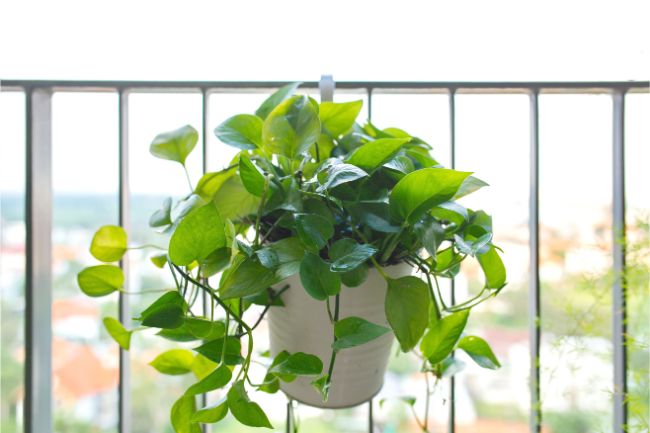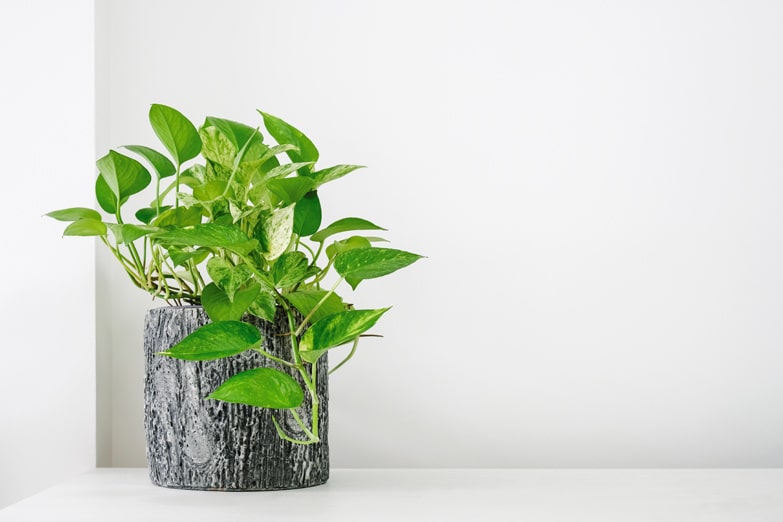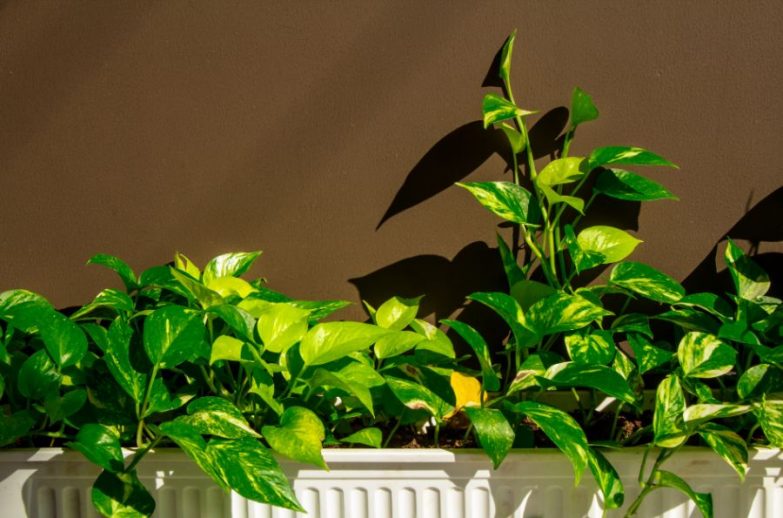People tend to choose Pothos houseplants because they’re supposed to be easy to grow and maintain. While these plants generally live up to their reputation, there are some things you should know to get the most out of them. That’s why I put together this guide on how to prune Pothos houseplants.
How to prune Pothos houseplants: Start by locating damaged, discolored, dead, and dying leaves. Using sterile pruners, cut them off the stem just below a healthy leaf node. Then, take care of any overgrown sections, shaping the plant to your liking.
There’s a lot to love about Pothos plants and they can stay with you for a long time if you learn how to take proper care of them. Pruning a Pothos houseplant is essential not only for how the plant looks but also to keep it healthy and thriving.
Everything You Need To Know About Pruning Pothos Houseplants
As popular as it is as a houseplant, Pothos is considered an invasive plant species and has earned the rather unflattering nickname of Devil’s Ivy. This luscious, trailing plant looks amazing in a hanging basket or a pot set on the table or floor but as it grows, it easily loops around almost anything in its path.
While this growth definitely adds to its charm, it’s often seen as both a blessing and a curse. If left unattended, a Pothos houseplant grows large, lush, and spreads quickly, giving your home or office a jungle-like atmosphere. This is why it’s so important to learn how to prune Pothos houseplants.
Pruning Pothos is a fairly simple process, but there are certain steps you should take to make sure it’s done correctly. With a little knowledge, you will develop your skills and boost your confidence so you feel more comfortable pruning Pothos and your other houseplants too.
When To Prune Pothos Houseplants
One of the first things to consider is when and when not to prune your Pothos plant. Thankfully, Pothos is considerably more hardy than many other houseplants, but it’s still better to prune it when it is actively growing. Pruning at the wrong time can lead to bare stems and vines or a stressed plant.
It’s best only to prune your Pothos during its growing period which is typically from spring into early fall. This allows the Pothos to recover quickly from the stress of being pruned and quickly establish new growth.
Why Should Prune Pothos Houseplants?
With the right growing conditions, Pothos plants grow quickly, and can become quite large over time. Maintaining the plant’s size so that it is suitable for the location it is growing in your home is the main reason for pruning, rather than for the health of the plant.
Pruning also helps stimulate new growth and can help to thicken foliage it you wish for a more compact growth for your plant. Some people prefer to grow Pothos within pots, so compact growth will be more desirable. Others prefer a trailing, vining growth habit, so pruning non-dominant stems can help to focus growth on longer stems and extend the length of the overall plant.
What Equipment Do You Need?
Equipment is pretty straightforward. All you need is a pair of sharp scissors and a few sheets of paper towels or newspapers to put under the plant as to not make a mess of the area where you’re pruning your plant.
You should ensure that your pruning shears are clean and sterile. Pruning is a common way disease is spread from one houseplant to the next, so take a few minutes to clean your pruners with rubbing alcohol or clean them with hot, soapy water.

How To Prune Pothos Houseplants
Now, down to the nitty-gritty. The pruning process begins with a careful examination of the plant. Locate any and all the damaged, discolored, dead, and dying leaves and stems you can find. These should be the first to go before you prune any healthy leaves or stems.
To encourage new growth and maintain your plant’s health, it’s best to find a spot where the stem is vigorous. Cut the stem just below a healthy leaf node. To clarify, you should leave the node on the plant. For those unsure of what a leaf node looks like, it’s simply a small protrusion on the stem where new growth forms.
Take at least an inch of healthy stem off along with the unhealthy stem and foliage. This will reduce the risk of the cut end from developing the same issue.
In addition to taking care of the sickly parts of your Pothos, you’ll probably also need to take care of some overgrown sections of healthy vines as well. You do this in a similar manner but first, plan exactly how you want your plant to look when you’re done.
There are many ways to trim your Pothos and each is attractive in its own unique way. Just be sure not to overdo any particular area and do some thoughtful planning beforehand.
After you have an idea of how you want your plant to look, start cutting the stems, shaping the plant into the general shape you desire, before fine-tuning later on.
You may wish to remove some whole, healthy stems all the way back to the soil. To do this properly, carefully trace each vine back to the soil and cut it anywhere from two to four inches from the soil surface. If possible, make your cut just after a leaf node.
Once this is done and your Pothos is neatly trimmed and attractive, it’s a good idea to quickly inspect your plant for signs of bugs. Pruning is a great opportunity to carefully inspect the foliage for bugs or other problems.
If you do find any, try treating your plant with one of these natural options to eradicate them.
Is There Any Way To Make A Pothos Fuller?
As I mentioned, pothos usually grows quickly so they don’t usually need a lot of help. But, if you want to make them look nice and full, there are a few things you can do. The most important one is to prune the plant properly because it stimulates growth and keeps the plant healthy.
Maintaining good care, including ensuring adequate light, water and fertilizer can also ensure a full and healthy plant. I generally recommend against fertilizing Pothos plants immediately after pruning. Sometimes fertilizing can stress the plant, particularly if applied in excess, and in addition to the stress of pruning, can lead to more harm than good.
Give the plant more sunlight. This is usually enough to stimulate a pothos to grow greener and fuller. Make sure they’re adequately watered and maintain a temperature of 65-85°F or 19-29°C.
Can I Propagate The Pothos Cuttings?
Pruning is the ideal time to create Pothos cuttings for propagation. Pothos can be easily propagated in soil or water. Just cut a section of stem 4-6 inches long, with several leaves on it. Ensure the bottom two inches of stem have no leaves and place this end in clean water or in a prepared pot with suitable potting soil.
Within a few weeks, your Pothos cuttings will have developed roots and may be growing some new leaves. Without too much difficulty, you can create a never ending supply of Pothos for your home or to give away to friends.
Why Are Pothos Houseplants So Popular?

There are a lot of reasons why these plants are such a common houseplant. First of all, Pothos plants are pretty wallet-friendly. In fact, a six-inch potted Pothos only costs about $10 to $15. That’s not all, it lasts a really long time with proper care which makes it one of the best bargains around when it comes to houseplants.
Compared to other houseplants, these are really easy to take care of. Pothos houseplants don’t need a lot of water or light to thrive indoors. That said, it’s still important to monitor them carefully to make sure they’re healthy. Be on the lookout for small leaves, lack of growth, or little to no variegation in leaf color. These are signs of not enough light and water.
Too much light and water aren’t good, either. Prolonged exposure to light leads to burnt leaves and over-watering can cause root rot. When it comes to watering these plants, experts agree that it’s best to keep the soil on the drier side so it’s best to wait until the top half of the soil is dry before watering again.
How long this takes depends on the temperature, pot size, and light exposure and can take anywhere from four to seven days. You should also keep your Pothos away from any heating and cooling ducts, though these plants are tough enough to survive and thrive in a wide range of temperatures.
Is A Pothos A Good Plant For Beginners?
Yes! This is a gorgeous plant that’s easy to prune and doesn’t require a lot of maintenance. Just make sure it has enough water and sunlight and this plant should thrive. It’s also a good choice if you want to learn about propagating plants. The skills you learn caring for a pothos will come in handy down the line as you pick up plants that require a little more care.

